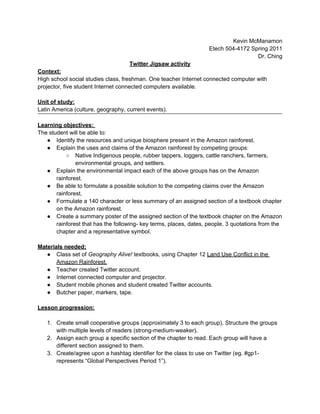
Twitter Jigsaw Activity Teaches Amazon Rainforest Conflict
- 1. Kevin McManamon Etech 504-4172 Spring 2011 Dr. Ching Twitter Jigsaw activity Context: High school social studies class, freshman. One teacher Internet connected computer with projector, five student Internet connected computers available. Unit of study: Latin America (culture, geography, current events). Learning objectives: The student will be able to: ● Identify the resources and unique biosphere present in the Amazon rainforest. ● Explain the uses and claims of the Amazon rainforest by competing groups: ○ Native Indigenous people, rubber tappers, loggers, cattle ranchers, farmers, environmental groups, and settlers. ● Explain the environmental impact each of the above groups has on the Amazon rainforest. ● Be able to formulate a possible solution to the competing claims over the Amazon rainforest. ● Formulate a 140 character or less summary of an assigned section of a textbook chapter on the Amazon rainforest. ● Create a summary poster of the assigned section of the textbook chapter on the Amazon rainforest that has the following- key terms, places, dates, people, 3 quotations from the chapter and a representative symbol. Materials needed: ● Class set of Geography Alive! textbooks, using Chapter 12 Land Use Conflict in the Amazon Rainforest. ● Teacher created Twitter account. ● Internet connected computer and projector. ● Student mobile phones and student created Twitter accounts. ● Butcher paper, markers, tape. Lesson progression: 1. Create small cooperative groups (approximately 3 to each group). Structure the groups with multiple levels of readers (strong-medium-weaker). 2. Assign each group a specific section of the chapter to read. Each group will have a different section assigned to them. 3. Create/agree upon a hashtag identifier for the class to use on Twitter (eg. #gp1- represents “Global Perspectives Period 1”).
- 2. 4. After each group has read their assigned section, have them send in a group tweet with a summary of what they have read. Tweets are limited to 140 characters or less, this forces them to collaborate, edit, revise and condense before tweeting. Stronger readers/ writers can help weaker group members. 5. Log in to teacher twitter account, project on screen and search for class specific hashtag. 6. Debrief/review chapter as a class. Ask each group to explain/defend their summative tweet. 7. Have each group then create a poster from their section of the chapter that has: a. Key terms, dates, names, places, three selected direct quotations from the reading they deem vital to understanding the section, and a symbol or drawing that represents the main idea of the section. 8. Class engages in a “Gallery Walk activity”- circulate around to view other’s posters. While at each station, they then send in three tweets: a. a comment on the poster they are viewing. b. something they learned from each poster. c. something they would like to know more about the content presented on each poster. *** Block class/ extension activity or homework: ● Assign groups to research more about their selected topic or find answers to the questions asked by peers. Find a web link, embed it into a Tweet. Assessment: Cooperative groups will propose a solution to for the competing groups involved in the Amazon rainforest. Make a 3 minute presentation to the class. Other groups tweet their reaction, assessment and feedback of the proposal. Hashtag searches can be used for class review and Internet based study guide. Justification for activity and theory: This lesson takes the classic “jigsaw” activity and adds the microblogging activity of Twitter to it. The jigsaw activity is a constructivist activity in which students are responsible for learning content and then teaching it to others. Vygotsky’ sociocultural ideas were predicated upon interaction between peers and between students and adults responsible for their education. The initial tweet of the section summary achieves this goal. Having each group defend or explain their tweet allows for elaboration on their part, clarification points made by the teacher when necessary and follow up questions asked by their peers. This forum allows the teacher to act as a clearinghouse (assessing informally the zone of proximal development) and scaffold content for the class as a whole or selected groups.
- 3. The summative posters create an artifact that other groups can interact with and learn from. The tweets they send out when viewing the other posters gives feedback to the group that created it. The cultural use of language, tweet-slang, emoticons and symbols is another aspect of the socio-cultural learning that takes place between peers as identified by Vygotsky. They alert the teacher to content the viewing group self reports as having “learned.” Finally, the “what I’d like to know more about” tweet provides a future task for the group that created the poster in order to provide an answer to the question posed by the visiting group. This is a type of peer generated scaffolding. Hart, D. (2006). Geography alive! regions and people.. Palo Alto, Calif.: Teachers' Curriculum Institute. Jaramillo, J. A. (1996). Vygotsky’s sociocultural theory and contributions to the development of constructivist curricula. Education, 117(1), 133-140.
